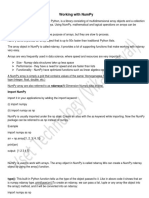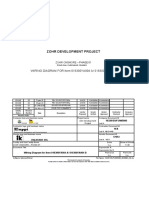0% found this document useful (0 votes)
15 views22 pagesNumpy Part-1
The document provides an overview of the numpy library, detailing its purpose for efficient array manipulation in Python, its speed advantages over traditional lists, and basic usage instructions. It covers various aspects such as array creation, dimensions, data types, and reshaping, along with examples of accessing and modifying array elements. Additionally, it highlights numpy's capabilities for flattening arrays and provides installation commands.
Uploaded by
vinay.agrawalCopyright
© © All Rights Reserved
We take content rights seriously. If you suspect this is your content, claim it here.
Available Formats
Download as PPTX, PDF, TXT or read online on Scribd
0% found this document useful (0 votes)
15 views22 pagesNumpy Part-1
The document provides an overview of the numpy library, detailing its purpose for efficient array manipulation in Python, its speed advantages over traditional lists, and basic usage instructions. It covers various aspects such as array creation, dimensions, data types, and reshaping, along with examples of accessing and modifying array elements. Additionally, it highlights numpy's capabilities for flattening arrays and provides installation commands.
Uploaded by
vinay.agrawalCopyright
© © All Rights Reserved
We take content rights seriously. If you suspect this is your content, claim it here.
Available Formats
Download as PPTX, PDF, TXT or read online on Scribd
/ 22




























































































